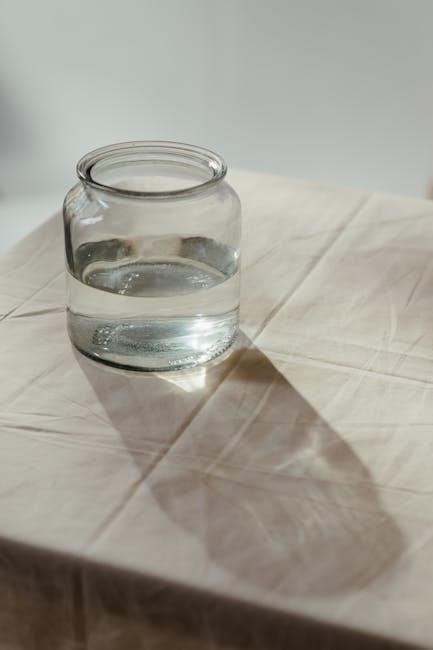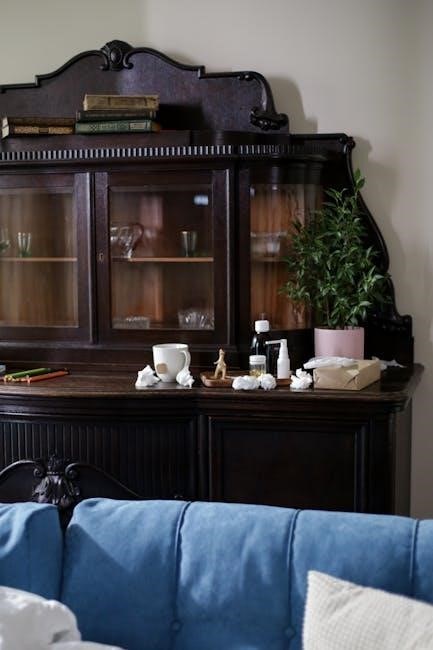Guided bone and tissue regeneration is a surgical procedure that enhances bone growth in deficient areas, commonly used in dentistry and medicine to restore lost structures.
1.1 Definition and Principles
Guided bone regeneration (GBR) and guided tissue regeneration (GTR) are surgical techniques that promote the growth of bone and periodontal tissues in deficient areas. These procedures utilize barriers or membranes to prevent unwanted tissue ingrowth, allowing preferred cells to populate the defect. The principle relies on creating a favorable biological environment for regeneration, ensuring space, stability, and vascularization. Biocompatible materials, such as membranes and bone substitutes, are often employed to guide the healing process. Growth factors and biologics further enhance the regenerative potential. The goal is to restore lost structures, enabling functional and aesthetic reconstruction, particularly in dental and maxillofacial applications.
1.2 Historical Background and Evolution
The concept of guided bone regeneration (GBR) and guided tissue regeneration (GTR) traces back to the 1950s and 1960s, when early experiments explored bone healing and periodontal repair. The term “guided tissue regeneration” emerged in the 1980s, focusing on barrier membranes to enhance healing. Pioneering work by researchers like Hurley and others laid the foundation for modern techniques. The development of non-resorbable and resorbable membranes in the late 20th century marked a significant milestone. Advances in biomaterials, bone substitutes, and growth factors further refined these methods. Today, GBR and GTR are integral to dental and medical practices, offering predictable outcomes for bone and tissue reconstruction.

Key Components of Guided Bone Regeneration
Guided bone regeneration involves three key components: membranes to prevent unwanted tissue growth, bone substitutes for structural support, and growth factors to enhance healing and cellular activity.
2.1 Membranes and Barriers

Membranes and barriers are essential in guided bone regeneration, preventing unwanted tissue invasion into the defect. They guide bone growth by creating a protected environment. Non-resorbable membranes, like titanium meshes, require removal, while bioresorbable options, such as collagen, degrade over time. These barriers are designed to promote osteogenesis by isolating the defect and allowing osteoblasts to proliferate. Their composition varies, from synthetic polymers to natural materials, ensuring biocompatibility and structural support. The choice of membrane depends on the defect’s complexity and healing requirements, making them a cornerstone in achieving predictable bone regeneration outcomes.

2.2 Bone Substitutes and Grafting Materials
Bone substitutes and grafting materials are critical in guided bone regeneration, serving as scaffolds for new bone growth. These materials are used to fill bone defects, promoting osteoconduction and, in some cases, osteoinduction. Common grafting materials include autografts (patient’s own bone), allografts (donor bone), xenografts (animal-derived), and synthetic ceramics like hydroxyapatite or calcium phosphate. Each material has unique properties, with autografts being the gold standard for compatibility but limited in supply. Synthetic options offer consistency and availability, while allografts and xenografts provide natural bone architecture. These materials support cellular ingrowth, vascularization, and bone remodeling, making them indispensable in achieving successful bone regeneration outcomes in both dental and medical applications.
2.3 Growth Factors and Biologics
Growth factors and biologics play a pivotal role in guided bone regeneration by enhancing cellular activity and promoting tissue repair. Proteins such as bone morphogenetic proteins (BMPs) and platelet-derived growth factor (PDGF) are commonly used to stimulate osteoblast proliferation and differentiation. These biologics are often combined with scaffolds like collagen or synthetic materials to ensure targeted delivery; BMP-2, for instance, is widely used in dental and orthopedic applications to induce bone formation. Biologics also reduce reliance on autografts, offering a more predictable and minimally invasive approach. However, their high cost and potential for off-target effects remain challenges. Despite these limitations, growth factors and biologics represent a cutting-edge advancement in bone and tissue regeneration, offering significant therapeutic potential.

Applications in Dental and Medical Fields
Guided bone and tissue regeneration is widely applied in dental implants, periodontal defect treatment, and maxillofacial reconstruction, enhancing bone growth for functional and aesthetic restoration in medical fields.
3.1 Dental Implants and Periodontal Defects
Guided bone regeneration plays a critical role in dental implants and treating periodontal defects. It is commonly used to enhance bone density in areas where implants are planned, ensuring a stable foundation. In cases of periodontal defects, this technique helps regenerate lost tissue and bone, preventing tooth loss. The procedure often involves the use of membranes, bone substitutes, and growth factors to guide the growth of new bone and tissue. This approach is particularly effective in restoring functionality and aesthetics in patients with severe bone deficiency. The integration of GBR with dental implant placement has significantly improved treatment outcomes, offering a reliable solution for patients with complex oral reconstruction needs.
3.2 Maxillofacial Reconstruction and Tissue Engineering
Guided bone and tissue regeneration is instrumental in maxillofacial reconstruction, addressing complex defects caused by trauma, tumors, or congenital anomalies. This technique enables the restoration of facial contours and functionality, ensuring aesthetic and structural harmony. Advanced biomaterials and bone substitutes are utilized to create scaffolds that promote tissue growth. Tissue engineering further enhances outcomes by incorporating stem cells and growth factors, allowing for customized grafts tailored to individual needs. These innovations have revolutionized the field, offering patients with severe maxillofacial defects a pathway to recovery and improved quality of life. The integration of regenerative technologies continues to expand the possibilities for reconstructive surgery, making it a cornerstone of modern maxillofacial rehabilitation.

Biomaterials and Their Role in Regeneration
Biomaterials are essential in guided regeneration, providing biocompatible scaffolds that promote cell growth and differentiation. They enhance tissue repair by mimicking natural structures and encouraging healing.
4.1 Types of Biomaterials Used
In guided bone and tissue regeneration, various biomaterials are utilized to facilitate healing. Natural polymers, such as collagen and chitosan, are biocompatible and promote cellular integration. Synthetic polymers like polylactic acid (PLA) and polyglycolic acid (PGA) offer controlled degradation and mechanical strength. Ceramics, including hydroxyapatite and calcium phosphates, mimic natural bone structure, enhancing osteoconductivity. Composite materials combine polymers and ceramics for improved performance. These biomaterials act as scaffolds, guiding cell proliferation and differentiation, and supporting tissue repair in deficient areas. Their properties can be tailored to specific applications, making them indispensable in regenerative therapies.
4.2 Stem Cells and Their Contribution
Stem cells play a pivotal role in guided bone and tissue regeneration by differentiating into specialized cells, such as osteoblasts, which are essential for bone formation. Mesenchymal stem cells (MSCs), found in bone marrow and adipose tissue, are widely used due to their ability to differentiate into various cell types. These cells contribute to tissue repair by secreting growth factors that promote angiogenesis and inhibit inflammation. Stem cells can be combined with biomaterials to create scaffolds that enhance regeneration. Their ability to integrate with existing tissues makes them a valuable tool in advancing regenerative therapies, offering potential for tailored treatments in dental and medical applications.

Challenges and Future Directions
Despite advancements, challenges like high costs, limited predictability, and material limitations persist. Future directions include 3D printing, stem cell therapies, and personalized regeneration techniques.
5.1 Current Limitations and Barriers
Despite its potential, guided bone and tissue regeneration faces challenges such as high costs, limited predictability, and material limitations. Immune responses to biomaterials and donor site morbidity remain concerns. Additionally, the complexity of techniques and variability in patient healing capacities pose barriers. Availability and regulatory approvals for advanced biologics and growth factors also restrict widespread adoption. These limitations highlight the need for further research and innovation to enhance outcomes and accessibility. Addressing these challenges is critical to advancing the field and ensuring broader clinical applications.
5.2 Emerging Trends and Innovations
Emerging trends in guided bone and tissue regeneration include advancements in 3D printing for customized grafts, bioactive materials, and stem cell therapies. Researchers are exploring smart biomaterials that adapt to tissue environments, enhancing regeneration. Innovations in growth factor delivery systems aim to optimize healing efficiency. Additionally, tissue engineering is being integrated with regenerative techniques to create functional constructs. These advancements promise to overcome current limitations, offering personalized and predictable outcomes. The integration of nanotechnology and biologics further highlights the potential for next-generation therapies, driving the field toward more effective and minimally invasive solutions.

